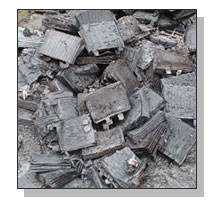Home > Lead Scrap > Lead Waste Recycling
Lead Waste Recycling
Batteries may be hazardous wastes because they contain heavy metals and
corrosive electrolyte solutions that are the source of their energy.
There are eight metals commonly used in batteries including Lead,
Mercury, Nickel, Cadmium, Lithium, Silver, Zinc, and Manganese.
Lead-acid batteries are most frequently used in automobiles, boats, and
other vehicles. Each battery contains lead and corrosive sulfuric acid
electrolyte solution. Smaller sealed lead-acid batteries have been used
in computers and cellular telephones.
 Waste Battery Management
Waste Battery Management
The Industrial waste management plan will address the following aspects:
- Treatment, Storage & reuse of Industrial Waste Water
- Storage & disposal of solid waste
- Monitoring of the quantity & quality of the waste treated, stored &
disposed of
- Operations and maintenance programme for waste management systems
Waste Lead Technology
The Industrial waste management programme will incorporate the
maintenance of log- books for the purpose of inventories of the
quantities and types of waste generated, stored and sent to external
disposal sites. Records will be kept of the waste quantities generated
on a daily basis and their waste characteristics shall be determined at
reasonable intervals especially when changes are anticipated.
Waste Water: Our plant does not make any water discharge as process is
dry in nature. We have to make up water in Wet Scrubber. Only wash-water
from worker shower drained out after settling Tanks and meet the
standards of effluent discharge in the water i.e., pH value of the
discharge water is between 7.0 to 8.5, total suspended solids in the
water is less than 500 mg/Lt. and the Lead concentration in the effluent
water is maximum 5 mg/Lt.
Solid Waste: The Smelting process finally generates Slag, which confirms
Lead contents below 2.0% by weight, and is non-leach able in nature and
can be used for land filling with contriving 550mg/Kg Soil Concentration
limit.
Disposal Technology for Lead Battery Waste
Air Emission control & Management
The Air Emission management plan will address the following aspects:
- Management programme for in-plant sources of air emission
- Operations and maintenance programme for air emission control systems
- Air Emissions Monitoring Programme
Air Pollution: The Lead Smelting Process (Pyrometallurgical) generates
Lead Dust, Lead Ash, SO2, CO etc. which is being controlled by our
Pollution Control Equipments. Our plant confirms Ambient Air norm for
Lead as 1.0 ug/m3 (24 hours).
Noise Emission Control & Management
The Noise control & management plan will address the following aspects:
- Monitoring & control of machinery Noise
- Monitoring & control of Noise Emitted by transport vehicles
Noise Pollution: Since very few rotating equipments generate noise, the
possibility of noise pollution occurring at the work place has been
taken into account. Our plant confirms the maximum noise level limit as
65 dB at day time and maximum of 55 dB in night time at plant perimeter.



 Waste Battery Management
Waste Battery Management


